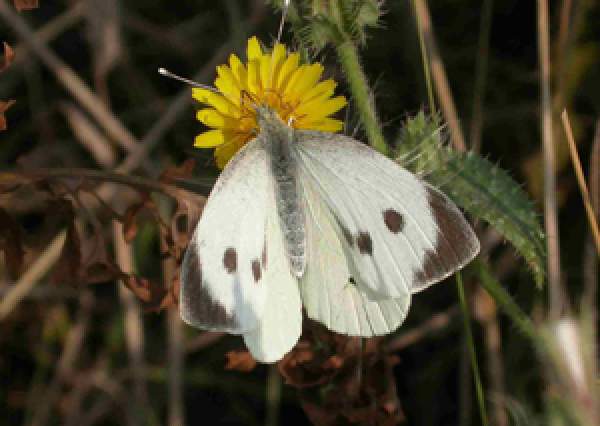Large White
Pieris brassicae

The Large White is perhaps the easiest of the three common British whites to identify. It is noticeably larger in size than the Small White and has stronger black markings on the forewings. The strength of these markings varies somewhat with wear, and is also dependent upon whether the individual is part of the first brood or second brood. Those from the second brood show the strongest markings. Males and females can be separated from each other when viewed with their wings open. Females have two black spots on both the upper and lower surfaces of the forewings. Males, on the other hand, only have the spots on the lower surface of the forewings.
The caterpillars can be found feeding in groups on favoured food plants. They are pale green and yellow in colour, speckled with black, and have a distinctive smell that arises from the mustard oils they contain as a defence against predators.
Large Whites usually have two generations per year, the first seen from April and the second emerging from July onwards. If the summer weather is favourable, then a smaller third brood may be on the wing in the autumn. Females search out brassica plants on which to lay batches of 50 or more eggs, and are attracted by the strong scent of mustard oils that these plants produce. The caterpillars use these oils to make themselves distasteful to potential predators like birds and small mammals, but they are no defence against the unwelcome attentions of the parasitic wasp Apanteles glomeratus, which lays its eggs within the developing caterpillar. In some years, the parasites may account for 95% of the mortality of the Large White larvae.
Numbers of Large Whites within Britain may be boosted by the arrival of immigrants from continental Europe. Set against this backdrop of pronounced fluctuations in abundance from one year to the next, there is some suggestion that populations in Britain are now smaller than they were last century. It seems likely that the widespread use of pesticides on brassica crops, together with other changes in farming practice, are responsible for this decline. Even the level of immigration may now be less than in former times.
It is also worth noting that Large Whites also like to use nasturtiums as a food plant and that these can be used to divert attention away from your crop of brassicas. I use a combination of net and nasturtiums in my own garden, which seems to do the trick, since I have both Large Whites and cabbages! Although there has been a recent run of poor years for this species, the longer term trend reveals no significant change in abundance.






Share this page